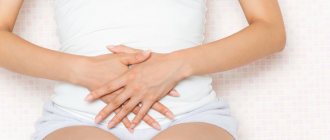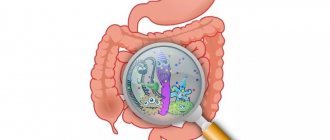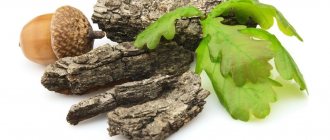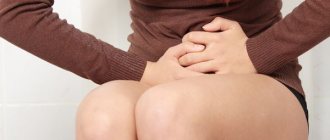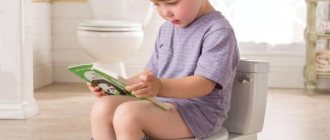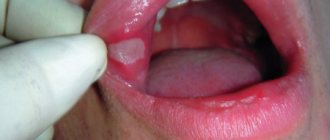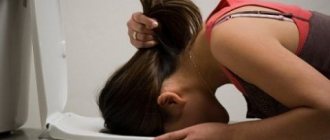The frequency and consistency of baby's stool is always a concern for attentive parents. There are standards defined by pediatricians, but each child is individual. For some children, daily bowel movements are considered correct; for others, breaks of 2–3 days are possible. However, if the number of bowel movements per day is more than three, then we are talking about diarrhea. It is important to note whether there are any impurities in the stool. They can signal the presence of dangerous diseases. Thus, diarrhea with foam in a child is extremely undesirable.
Additional symptoms
Diarrhea with blisters in adults and children is not an independent disease. Diarrhea is a manifestation of the underlying disease. Symptoms directly depend on the existing pathology, and treatment is selected on an individual basis.
The main signs accompanying foamy diarrhea include:
- rumbling in the digestive organ, regardless of meals;
- fetid sour odor of fecal matter;
- the presence of undigested food or starch grains in the feces;
- pain during bowel movements in rare cases.
Unreasonable rumbling of the abdomen is an additional symptom of the disease.
Yellow diarrhea with foam in an adult or child may indicate the presence of an infectious lesion. In this case, the patient complains of:
- increase in body temperature;
- general malaise;
- acute painful sensation in the stomach;
- significant loss of strength.
The patient's appearance may deteriorate due to a violation of the water-salt balance. The skin becomes dry and pale, rashes and peeling are present on the skin.
We have selected useful articles on the topic
The main causes of diarrhea during a trip to the sea and the best ways to eliminate them
02.06.2019
Why does colitis occur in the lower abdomen?
02.06.2019
What foods increase the process of gas formation and why?
02.06.2019
Yellow and white foamy diarrhea occurs in children and adults up to 10 times a day. Fecal matter has a foul odor. The process of bowel movement can cause significant discomfort.
The video explains what loose stools may indicate:
Treatment
The main therapy is prescribed according to the identified disease and the severity of its manifestations. However, if the symptoms do not bother you too much, and there are no additional signs of deterioration in your health, you can try to eliminate the diarrhea on your own.
If the frequency of bowel movements exceeds 4 times a day, you need to dilute 1 packet of Regidron per liter of water and drink throughout the day. This will help cope with the loss of water and mineral salts.
For an astringent effect and removal of toxins, use Smecta, Enterosgel, Polysorb or Atoxil. These drugs also have an antimicrobial effect and promote wound healing. Thanks to their enveloping properties, they protect the intestines and relieve inflammation.
For one-time use, you can take drugs that normalize peristalsis. Loperamide hydrochloride (Imodium) is a good choice, as it slows down motility and restores food digestion.
After diarrhea stops, you need to take a course of probiotics, which will help restore beneficial bacteria. You can use Linex, Bifidumbacterin, Hilak-Forte. These preparations contain live lacto- and bifidobacteria, which repopulate the intestines and restore its natural immune barrier.
Causes of the symptom
The causes of loose, foamy stool in an adult or child are varied and require comprehensive diagnosis. Provoking factors are described in the table.
| Provoking factor | Description |
| Infectious lesions in the intestines | Pathology is a consequence of the ingress of pathogenic microorganisms or viruses. These include salmonella, enterovirus, etc. Foamy diarrhea in this case is accompanied by an increase in body temperature. The patient complains of general weakness, painful sensation in the digestive organ and the urge to vomit. The condition cannot improve on its own. Complex treatment is required. |
| Change in natural microflora | A change in the natural microflora for the worse provokes the appearance of dysbacteriosis. Normally, only 1% of pathological microorganisms are present in the human body. Negative changes may be due to:
With these disorders, the number of pathogenic microorganisms in the body increases. General signs of intoxication and loose stools appear. |
| Individual intolerance | Often foaming diarrhea occurs in a child or adult if there is an individual intolerance to any food product. Diarrhea can be caused by:
Various medications can cause allergies and then loose stools. The patient's condition improves when he stops using the allergen. |
| Lactose deficiency | This root cause provokes the appearance of loose stools in a child. The condition is considered normal if it is not accompanied by signs of intoxication of the body. In adults, the factor rarely causes diarrhea. |
| Fermentation process in the stomach | Causes of loose, foamy stools in adults and children include fermentative dyspepsia. An unpleasant symptom is a consequence of consuming foods that provoke the fermentation process. |
| Helminthiasis | Helminth infections can be accompanied by both constipation and foamy stools. In pathology, the human body contains parasitic microorganisms that worsen the condition of the entire organism. |
| Inflammatory process in the digestive organs | Foamy stools are a consequence of the presence of pathologies accompanied by an inflammatory process. These include:
Patients, as a rule, ignore the symptom, and the disease becomes protracted. |
| Gluten intolerance | In this case, the patient’s body perceives gluten as a foreign substance. An inflammatory process occurs in the digestive organ. One of the symptoms of this disorder is foamy stools. |
Pathogens of diarrhea
The formation of the microflora inhabiting the intestines occurs gradually.
Newborns still lack many microorganisms important for digestion in the gastrointestinal tract. For this reason, during breastfeeding, they react sharply to even minor changes in the mother's diet. In newborns, frequent and loose stools are not a problem, because feeding with breast milk or formula promotes such a stool consistency. However, not all enzymes in the baby's body are released in a timely manner, which can cause explosive diarrhea with foam and mucus. The color of stool varies from bright yellow to swamp green.
Dysbacteriosis often provokes stool disorders, so if treatment with antibiotics was carried out, it may require restoration with the help of natural yoghurts and probiotics, which stabilize the balance of microorganisms in the intestines.
Diarrhea is a whole complex of symptoms that relate not only to diarrhea, but also to the general well-being of the child. With diarrhea, the stool is thin and watery, the child goes to the toilet every hour, and sometimes more often. Simultaneously with loose stools appear:
- skin rashes and irritation;
- pain and bloating in the abdomen;
- temperature increase;
- nausea and vomiting, in infants - profuse regurgitation.
Sometimes some of the signs, such as skin rashes, may be absent. In rare cases, diarrhea may indicate a more serious condition, such as:
- enterocolitis (inflammation of the small and large intestines);
- entry into the intestines of a viral, bacterial or fungal infection;
- parasite infection;
- hepatitis;
- colitis, pancreatitis, gastritis.
Various intestinal infections are very common among children, so if diarrhea lasts longer than 3 days, you should definitely visit a pediatrician or at least see a doctor in kindergarten. The child may be contagious to others and need urgent help.
In addition to the obvious discomfort, diarrhea is dangerous because fluid, vitamins and microelements are actively washed out of the body, which leads to dehydration. In times when medical care was not as effective as it is now, diarrhea often claimed the lives of young children.
In developing countries, many children still die from diarrhea. Along with fluid, electrolytes, which are important for stable heart function, are washed out of the body. Dehydration can be determined by the following signs:
- the skin becomes dry and flaky;
- the child is constantly thirsty;
- dark circles appear around the eyes;
- drowsiness, weakness and lethargy develops;
- loss of appetite occurs;
- urine becomes dark and its quantity decreases.
This condition is very dangerous in infants. If your child urinates less than 10 times a day with debilitating diarrhea, you should contact your pediatrician as soon as possible. For children of primary school age, urination less than 4 times a day is abnormal. Infections that can cause foamy diarrhea:
- staphylococcus;
- salmonellosis;
- enterovirus;
- coli;
- rotavirus infection;
- dysentery;
- cytomegalovirus;
- fungal infections.
What can be done to alleviate the child’s condition? First of all, you need to call a pediatrician or visit a medical facility for a correct diagnosis. If diarrhea continues for more than 3 days, medical attention is required.
- fermented milk products, milk;
- fried food;
- everything that causes flatulence: legumes, cabbage, carbonated drinks;
- sweets and baked goods.
For infants, it is impossible to exclude milk, so adequate measures should be selected together with the pediatrician. Breastfed babies often react violently to changes in their mother's diet.
An adult body can easily cope with foods that are not the first freshness, but when toxins enter the baby’s gastrointestinal tract with milk, he cannot neutralize them and becomes poisoned. To prevent dehydration, children over 2 years of age can be given Regidron, Glucosolan or similar drugs.
You can give lightly salted water and sweet tea to drink. In case of poisoning, you can take activated carbon in accordance with the instructions.
Yellow diarrhea in a child is a sign of the development of a disease in the intestines. Diarrhea can be caused by improper digestion of food, poisoning, or taking medications. Loose stools in children require immediate treatment.
Yellow stool indicates an upset stomach. The causes of its appearance are divided into infectious and non-infectious.
Infectious:
- rotavirus;
- harmful bacteria;
- inflammation of the mucous membranes in the intestines.
Non-infectious:
- lactose intolerance;
- poisoning;
- taking medications, such as antibiotics;
- stress;
- intestinal inflammation;
- non-invasive infections.
In infants, changes in stool are often associated with the mother's diet. The cause of diarrhea if the baby is bottle-fed is an incorrectly prepared formula.
When the stool changes, accompanying symptoms appear that will help determine the exact cause of the yellow stool.
Symptoms
Diarrhea in children appears suddenly and is accompanied by visible symptoms. Diarrhea begins with seething in the stomach, pain, and the urge to go to the toilet becomes more frequent.
Associated symptoms:
- lack of appetite;
- the skin becomes pale;
- worsening mood, drowsiness;
- frequent loose stools;
- nausea;
- temperature increase.
Young children become capricious. The appearance of symptoms requires parents to provide first aid, and it is also necessary to call an ambulance.
Foamy stools indicate intoxication of the body caused by fatty, spicy foods. Diarrhea for less than 3 days is not dangerous and goes away on its own if you follow a diet.
Causes:
- dysbacteriosis;
- viral infection;
- helminthiasis;
- inflammation of the stomach;
- eating fatty, spicy foods.
In a newborn, diarrhea with foam appears due to failure to absorb breast milk or formula. During the complementary feeding period, a new product can cause changes in stool. Seeing a doctor requires the presence of pus and bloody spots in the stool.
An increase in body temperature above 38 degrees Celsius with diarrhea indicates the presence of an infection in the baby’s body.
Causes:
- Rotavirus, which is accompanied by yellow stools and vomiting.
- Teething.
- Intestinal infections.
High temperature is accompanied by loss of strength and lack of appetite. If the use of antipyretics does not give the desired effect, it is recommended to consult a doctor to avoid dehydration.
Loose stools without fever indicate a malnutrition or food poisoning. In newborns, feces in the first weeks have a yellowish tint and are not a symptom of intestinal diseases.
Food allergies lead to bowel dysfunction. Parasitic infections occur without an increase in body temperature, but the stool becomes yellowish.
Nausea and vomiting
Light yellow diarrhea and vomiting in a child may be due to exposure to an infectious disease, a cold. Symptoms affect the intestinal mucosa and lead to water imbalance.
What to pay attention to:
- weight loss;
- blood streaks in stool;
- rare urge to go to the toilet;
- dark yellow urine.
All signs indicate dehydration if they do not stop for more than a day. If signs of infection appear in a child under one year old, it is recommended to call an ambulance.
Watery diarrhea
Watery diarrhea occurs due to indigestion. In the presence of fever, the “culprit” of diarrhea is considered to be a rotavirus infection.
Causes:
- stressful situations;
- cold;
- poor nutrition;
- intestinal infections;
- dysbiosis.
Associated symptoms may include abdominal pain and refusal to eat.
Diarrhea with mucus
Stool with mucus and a sour odor indicates the presence of bacteria in the intestines. They appear due to poor personal hygiene.
Nausea, vomiting, chills are symptoms of an intestinal infection. It often occurs in young children.
Mucus in the stool appears after taking antibiotics and drugs for the treatment of bronchitis. In newborns, diarrhea is associated with the introduction of new foods, fruits and vegetables.
Light-colored stools in children appear due to excessive consumption of dairy products. Normally it goes away within 2 days.
From the age of 2 years, light yellow diarrhea means that the digestive tract is not working properly. The liver cannot cope; enzymes are not produced to color stool dark.
Frequent diarrhea leads to dehydration. It is necessary to identify the cause of the condition and begin immediate treatment.
Why does frequent diarrhea occur in children?
- there is a violation of the intestines;
- there is lactose intolerance;
- infectious and cold diseases appeared.
Diarrhea for more than three days has an adverse effect on the child’s body and leads to dehydration.
A one-month-old baby's stool is bright yellow to light in color. This condition is not a pathology and no treatment is required.
Changes in stool in children under one year old, the appearance of an unpleasant odor, inclusions of mucus, are the causes of intestinal dysfunction. When taking antibiotics, the microflora changes.
Causes:
- feeding schedule is disrupted;
- dysbacteriosis;
- lactose intolerance;
- failure to follow instructions for preparing formula;
- teething;
- diseases of the intestines, liver;
- infections.
With dysbacteriosis, the stool is quite liquid and foamy. Normally, this phenomenon occurs in the first 3 weeks of a baby’s life. At 7 months, the first complementary foods are started, which can also cause diarrhea and yellowish stools.
Breastfeeding requires a woman to follow nutritional rules to avoid diarrhea in her baby. It is recommended to exclude legumes, fatty foods, fried foods, and carbonated drinks.
When to see a doctor:
- The baby constantly cries and kicks his legs.
- The baby refuses to eat.
- Mucus and streaks of blood appear in the stool.
- Heat.
- Skin tone changes.
Prevention of diarrhea in infants includes the diet of the nursing mother and the rules for introducing complementary foods. All food products are thoroughly washed and, if possible, treated thermally.
Treatment methods
Presence of symptom in adults
Often, diarrhea with foam in an adult without fever is the only manifestation of intestinal dysfunction at an early stage. If left untreated, the patient's condition will worsen. The sick person will begin to complain about:
- urge to vomit and constant nausea;
- the presence of foreign matter in fecal matter;
- increase in body temperature;
- painful sensation in the digestive organ;
- skin rashes.
The causes and treatment of diarrhea with foam in an adult are individual. If a symptom is present, it is important to immediately consult a doctor for a comprehensive diagnosis. Otherwise, there is a high risk of dehydration. Complications may develop.
If you have problems with the gastrointestinal tract, in addition to diarrhea, vomiting may occur
Diarrhea with foam during pregnancy is caused by active restructuring of the body. Most often the symptom occurs in the first trimester. The condition is characterized by elevated levels of progesterone.
Help with foamy diarrhea in a child
Foamy diarrhea is a pathological condition that requires a thorough diagnostic examination and the help of a doctor. In case of diarrhea, it is necessary to exclude dairy products and foods containing wheat flour from the child’s diet. It is also undesirable to consume foods rich in fiber. To avoid dehydration, it is necessary to give your child as much fluid as possible.
To speed up the restoration of the natural rhythm of the intestines and eliminate the negative symptoms of diarrhea as soon as possible, your doctor may recommend using the drug IMODIUM® Express. Its active component stimulates the absorption of water and salts from the intestines, increases the tone of the anal sphincter and reduces the urge to defecate. Contraindicated in children under 6 years of age.
Presence of symptoms in children
Diarrhea with foam in a breastfed baby is a consequence of an imbalance between hind and foremilk. They differ significantly in consistency and composition. The symptom is caused by improper feeding, when a woman often changes breasts.
The baby’s symptom is also due to an incompletely formed organism. If left untreated, it can cause secondary lactose intolerance. The degree of neglect of the condition is determined by the condition of the child and the results of laboratory tests.
Diarrhea with foam in a child may indicate completely different problems.
Diarrhea with foam in a 2-year-old child without fever may be due to an incorrect diet. Parents often give their children foods that can trigger the fermentation process. These include:
- chocolate;
- smoked meats;
- fatty and fried;
- confectionery.
A child has diarrhea with foam and fever - common signs of helminthic infestation. In addition, the baby may complain of unbearable itching in the anus. The condition is rapidly deteriorating.
Increased temperature with diarrhea is an additional diagnostic sign
Diet features
In order for foamy diarrhea to go away as quickly as possible, treatment should be combined with diet. If you exclude certain foods from your diet, you can do without medications. At the first manifestations of the disease, it is recommended to avoid heavy and fatty foods, exotic fruits and dairy products. A diet based on rice boiled in water without salt and fat is considered very effective. Rye bread is also a healthy product. The only fruit allowed is bananas. It is important to maintain water balance. You should drink a lot and it is best to brew teas from linden, raspberry, chamomile, and non-carbonated mineral alkaline water is also useful.
The diet is aimed at restoring intestinal function, so it is necessary to exclude foods that irritate it. If you follow these recommendations, your stool will normalize after a while. To avoid relapse of the disease, you should give up spicy and unusual foods, and return to your usual diet gradually.
Symptom elimination methods
It is possible to eliminate loose stools with foam in a child or adult only after the root cause of the pathology has been established. Treatment is selected on an individual basis. With diarrhea, the body loses a huge amount of fluid. The patient must make up for the deficiency. Recommended to drink:
- strong and slightly sweetened teas;
- various herbal tinctures in the absence of individual intolerance;
- special solutions;
- dried fruit compotes;
- as much regular boiled water as possible.
For the first few days, the patient is recommended to observe therapeutic fasting. After the specified period of time, the patient is transferred to a balanced diet.
One of the recommendations for eliminating diarrhea is to drink strong tea.
Medicines can only be selected by a doctor, taking into account the characteristics of the body.
Ways to eliminate foamy feces
Liquid, foamy feces against the background of the child’s deteriorating condition requires an immediate call to the ambulance and placement of the baby in a medical facility. Dehydration develops quickly in children; inept actions of parents can harm the health of the baby.
If the child feels relatively well, there is no vomiting or fever, but there is diarrhea with foam, gas, and abdominal discomfort, you can try home therapy. Features of the treatment of foamy loose stools are as follows:
- Replenishing fluid loss by drinking water, mineral water without gas, salt rehydrants such as Regidron, Oralit, Humana.
- Removing intoxication with sorbents. For these purposes, children use Smecta or rice broth. Passing through the intestines, these agents absorb excess water, toxic substances, and compact stool.
- Preparations that suppress foaming in the intestines in children, based on simethicone: Sab Simplex, Espumisan L, Bobotik. Herbal medicines for gases in infants - Plantex, extracts of fennel, anise, caraway, dill, mint.
- Astringent herbal remedies for diarrhea - decoctions of chamomile, sage, St. John's wort, oak bark, pomegranate peels.
- Colonization of the intestines with beneficial symbionts using the drugs Linex, Hilak Forte, Acipol, Bifidumbacterin and other probiotics. Cultures of lactic acid bacteria are contained in kefir, fermented baked milk, yogurt, cottage cheese, and yogurt.
- Changing your diet is important to combat dysbiosis. Fresh vegetables, fruits, and cereals rich in fiber will serve as a breeding ground for the necessary microbes. Preferred sources of animal proteins are chicken, turkey, rabbit, pike perch, and greenling fillets. Sweet, spicy, fatty, fried, pickled foods should be excluded.
Acute intestinal infection (AI)
OCI is accompanied not only by loose, foamy stools, but also by increased body temperature, vomiting and pain in the abdominal area (another cause of abdominal pain and vomiting). With such symptoms, it would be best to seek help from a doctor as soon as possible. The causes of this disease are pathogens that enter the digestive system with dirty food, water, unwashed hands or expired food.
Important: while you are waiting for the doctor, be sure to give your child something to drink, but in small portions.
